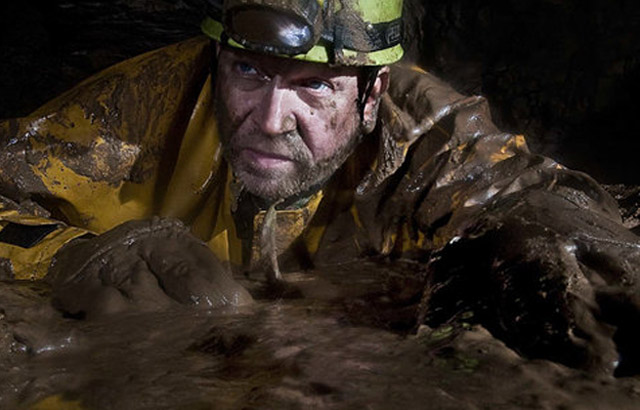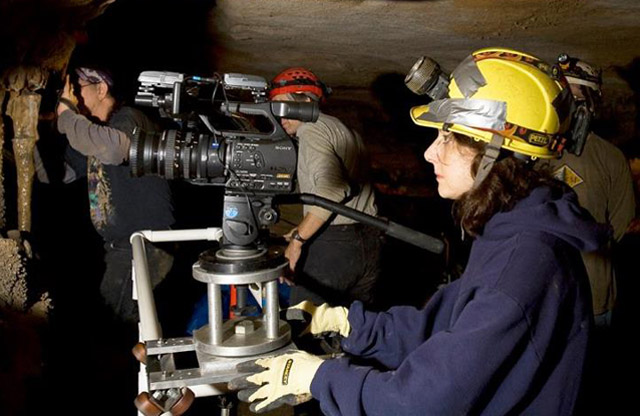CHICAGO – In anticipation of the scariest week of the year, HollywoodChicago.com launches its 2024 Movie Gifts series, which will suggest DVDs and collections for holiday giving.
Interviews: Director Janet Tobias, Holocaust Survivors Speak of ‘No Place on Earth’
CHICAGO – As more stories of the Holocaust – the genocide of the Jewish people by Adolph Hitler and the Nazi Party during World War II – come to light, new horrible situations are related by those who survived. In the battle over the Ukraine, five families of Jews escaped death by hiding in a cave for a record number of days. Their story is told in “No Place on Earth.”
The account of this phenomenon begins in the modern day. Cave explorer Chris Nicola of New York City descended into “Popowa Yama,” a grotto in the largest cave system of the Ukraine. There he came across astounding evidence that people once lived there, and what he finds – bottles, sewing equipment and clothing – indicate that the occupation of the grotto was in the recent past. Nicola’s further research unearths an amazing fact of history. He discovers that the items belonged to five Jewish families who lived in the cave, underground and undetected, from their Nazi enemies during the period of the Holocaust.
 Photo credit: Magnolia Pictures |
Chris Nicola’s tenacious follow through inspired filmmaker Janet Tobias to expand his findings into a documentary. She interviewed the survivors – who were teenagers and children back then, and now are old men and women – as they related the astounding story of their persistence to remain alive. The area of the Ukraine where they lived had one of the largest Jewish populations in the world before the war, afterward only five percent of those Jews survived.
HollywoodChicago.com interviewed director Janet Tobias of “No Place on Earth,” who made the film in association with the History Channel, and also had the privilege to sit down with three actual survivors of that horrific experience – Sima Dodyk Blitzer, Sonia Dodyk Hochman and Sam Stermer.
 Director Janet Tobias of “No Place on Earth”
Director Janet Tobias of “No Place on Earth”
HollywoodChicago.com: What led you to this story? Did you find through Chris Nicola or from some other source? And what was the process that got it to the screen?
Janet Tobias: A colleague of mine from PBS had the original source – the National Geographic adventure article which Chris Nicola had put together – and told me it was an incredible angle on the Holocaust. I then went and met the Stermer family, and I thought that they were unbelievable storytellers. They related this experience in a way that I had never heard stories of the Holocaust told. I just had to do the documentary.
 Photo credit: Magnolia Pictures |
I met Chris Nicola, who is Indiana Jones meets a New York state investigator, and then the journey of the film started. It took about five and a half years, two years from the start of filming.
HollywoodChicago.com: Did you initially get interest from the History Channel or did that come about during the financing process?
Tobias: They were the first on board, but it took awhile to get the other partners lined up. We have British, German and American partners. It took an international group to get the film together.
HollywoodChicago.com: What did you want to get absolutely right about the re-creations? What obstacles did you have regarding that authenticity?
Tobias: Sam [Stermer] told me early on that it was important to the film that there was nothing less and nothing more than the story itself, so the facts were really important to this family. One relative had very carefully and masterfully written a book for the family in 1960, which laid out the facts. I come from a journalistic background, so the facts were very important to me.
On the re-creation side, the hurdles were about shooting underground, which was very complex. Finding the right locations, and filming in low lighting conditions – which was important because the families lived with minimal lighting, so we wanted to replicate that with candlelight and lanterns. We wanted the audience to also have a feel for the claustrophobia, the mud, the humidity and that darkness.
HollywoodChicago.com: t has been 11 years since you last directed a documentary. What element of this story motivated you to get the opportunity to direct again?
Tobias: After working at PBS until 2002, I changed careers to technology and medicine. Even though that career bloomed, I missed directing too much. It was the power of stories that brought me back, they grab hold of me in ways I don’t expect and take me to other places. When my friend brought me this story, because he knew I was looking for one, I realized that it was the one I wanted to do. Since completing this documentary, I realize I’m going to stay in directing.
HollywoodChicago.com: This is a story of survival against unimaginable conditions. Given the research you did about the cave life of these survivors, what part of their experience did you find hardest for you to understand?
Tobias: I went into the cave for the first time about five years ago. I’m not claustrophobic and I’m fairly athletic, so getting into the cave wasn’t a problem. There were a couple of things that overwhelmed me, the first being the darkness. We turned off the lights for five minutes, and it was so dark it was unimaginable that anybody would survive this for weeks on end. A cave redefines the dark. We live with ambient light around us – street lights, car lights, even the forest has moonlight – but in a cave there is nothing, you literally cannot see the hand in front of you. The idea of that much darkness was overwhelming to me.
The second thing was about dragging cable, equipment and running water down into the cave during filming, and it was the physical labor involved. The idea that one of survivors wedged a 100 lb. stone down the hole, and the boys and men kept supplies running down there, is an incredible feat of physical ability and courage. Every week they went out, knowing if they put their head above the ground they could be killed. It made me admire young men and boys, that they are capable of crazy and brave things. And they will fight for their families and friends in ways that mirrored the old-fashioned heroes of the movies we used to watch and love.
 Holocaust Survivors of “No Place on Earth”
Holocaust Survivors of “No Place on Earth”
The actual people who survived the cave dwelling experience include sisters Sima Dodyk Blitzer and Sonia Dodyk Hochman, as well as Sam Stermer.
HollywoodChicago.com: Sonia, who was the first person outside your family, did you finally tell this story to, and why did you happen to tell that person? What brought it up?
Sonia Dodyk Hochman: That would be in 1947, when I came to the United States, and I met my grandparents’ sister, who lived in the Bronx, and she was the one who I first told the story to, outside my immediate family.
HollywoodChicago.com: Sima, what still connects you to your Polish roots, from your days in the Ukraine. What feels most Polish to you now?
Sima Dodyk Blitzer: I don’t feel those roots anymore. I was born there, but given what occurred when I was a child they weren’t very nice to us. Our Ukrainian neighbors were very hostile, and would point us out to the Germans when they came in. They would point out where the Jews were hiding, and they collaborated with the Germans. I cannot say I have good memories of our neighbors.
HollywoodChicago.com: Sam, did you ever find yourself reliving the horrible experience in dreams, and how would those dreams play out?
Sam Stermer: 20 years after the war, every night I had dreams. Even though we didn’t suffer as much as other people, because we were in the cave rather than a ghetto, but because of the fear we lived in, I had dreams every night for the 20 years afterward. I would dream that the Germans or the Ukrainian police were coming after us, shooting us. After that period, the dreams disappeared, but even now when I have problems they do reoccur.
HollywoodChicago.com: Sonia, what do you feel is the greatest fear that came out of that cave. In other words, what burden in your own life have you carried with you since that experience?
Dodyk Hochman: It’s the fear that was generated through when my father and uncles would go out to get food for us in the cave, I never knew if they would come back or not. And to this day, sometimes I have dreams myself – that I’m the mother, hiding with my children – and I have the same fear in the dream, waiting for the men to come back with food.
Photo credit: Patrick McDonald for HollywoodChicago.com |
HollywoodChicago.com: Does that spillover to your everyday life?
Dodyk Hochman: Well, whenever we get together we always talk about the grotto, it seems to be with us continuously. Sometimes we get together for dinner, and we say we’re not going to talk about. We get through the first couple of courses, and right around the main course, somebody brings up a word about it, and by dessert we’re talking about it again.
HollywoodChicago.com: Sima, now that you have had time as an adult to study about the history you experienced as a child, what aspect of that history really haunted you or made you feel the most angry?
Dodyk Blitzer: I learned that my nation was decimated, a third of the population were Jews and they were mostly all gone by the end of the war, murdered for no reason other than being Jewish. It’s mind boggling, I cannot to this day understand what the Germans had against the Jews, we weren’t even on their land so far away in the Ukraine. We suffered terribly, but it wasn’t until later I found out about the concentration camps, I found out that the Nazis would search house-to-house, and send our people to the Belzac concentration camps [southeastern Poland], where they would die in gas chambers.
My grandparents on my father’s side had a bunker, and they were a large family. When the Germans came in and started searching for Jewish people in October of 1942, a neighbor named Gardener pointed out to the soldiers where my family’s hiding place was. They pulled them out, killed my 93 year old grandfather as he was trying to escape, and put the rest of them on the cattle cars and sent them to Belzac. And you ask me what is there to be angry about?
HollywoodChicago.com: When did you study that history when you got older?
Dodyk Blitzer: Since I lived through it, I lived it my entire life. I always wondered what kind of world do we live in, when one nation decides they’re going to eliminate another nation? The Germans were in a middle of a war, and they took time to concentrate on killing the Jews? It seems to me that’s what all they did.
HollywoodChicago.com: Sonia, in reliving this experience, what was the most difficult element that came back to you in the retelling?
Dodyk Hochman: It was after liberation. We survived, we were alive, pretty much the whole family. We were rich in that way. We were liberated in April of 1944, but in November of that year my grandfather was killed by Ukrainian authorities, and my father was killed the next month. Our joy of survival turned into my widowed mother crying for weeks. We never found my father’s body, we never put him to rest. And to this day, I have dreams that my father is coming home. I ask him in those dreams ‘where were you?’
Stermer: They also killed my father. When we came back in 1990, we wanted to pay our respects in the town where we buried him. We decided we were going to bring his remains back with us to Canada. So when we got there, we walked to the cemetery, and it suddenly it wasn’t there. They had made a sports field by just plowing over my father’s remains, and the people who died in the ghetto. Could you imagine our feelings?
HollywoodChicago.com: Sima, since you have lived a long life after having gone through the experience as a child, is there something positive about the state of the world as it has evolved?
Dodyk Blitzer: There was one marvelous thing that happened, when the state of Israel was reborn. We were essentially driven from our country, and we were delighted to find refuge in Canada and the United States, these are two amazing countries. But still, to have our Biblical country back, that is the most miraculous thing. And that happened as a direct effect from the Holocaust.
Stermer: I would have walked to Israel back then if it existed, because this was our dream. We now have something to show that we don’t have to live in fear in other countries, there is now a place to protect us.
 | By PATRICK McDONALD |


